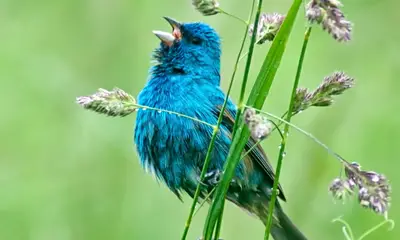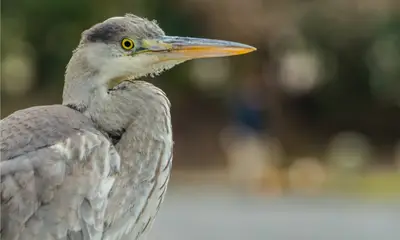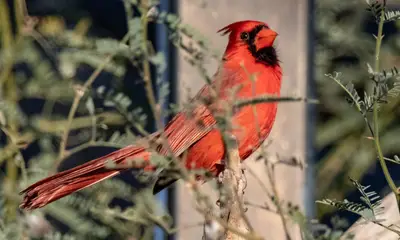Top 31 COMMON BIRDS In Arizona (ID Guide With Photos)
Did you recently come across a familiar bird in Arizona, and want to know what species it was?
Bird identification in Arizona is not as easy as it might seem, since there are many bird species in the Grand Canyon State that look similar.
To help you identify the bird you saw, we’ll cover the most common birds of Arizona in this article, and where to find them.

What are the common birds found in Arizona?
The 31 most common birds found in Arizona are:
- House Finch
- Mourning Dove
- Lesser Goldfinch
- Verdin
- Gila Woodpecker
- Northern Cardinal
- American Robin
- Northern Mockingbird
- House Sparrow
- American Crow
- Cactus Wren
- Common Starling
- White-winged Dove
- Red-winged Blackbird
- Downy Woodpecker
- Hairy Woodpecker
- House Wren
- Yellow-rumped Warbler
- Bullock’s Oriole
- Barn Swallow
- Violet-green Swallow
- Yellow Warbler
- Western Bluebird
- Pyrrhuloxia
- Anna’s Hummingbird
- Lazuli Bunting
- Common Ground Dove
- Woodhouse’s Scrub Jay
- Steller’s Jay
- Chipping Sparrow
- Song Sparrow
While many of these Arizona birds are year-round residents, some are migratory birds that only occur in the Grand Canyon State during the summer or winter months.
Now let’s dive into the details, and take a closer look at each of these common species in order to get the full scoop:
House Finch
Scientific name: Haemorhous mexicanus
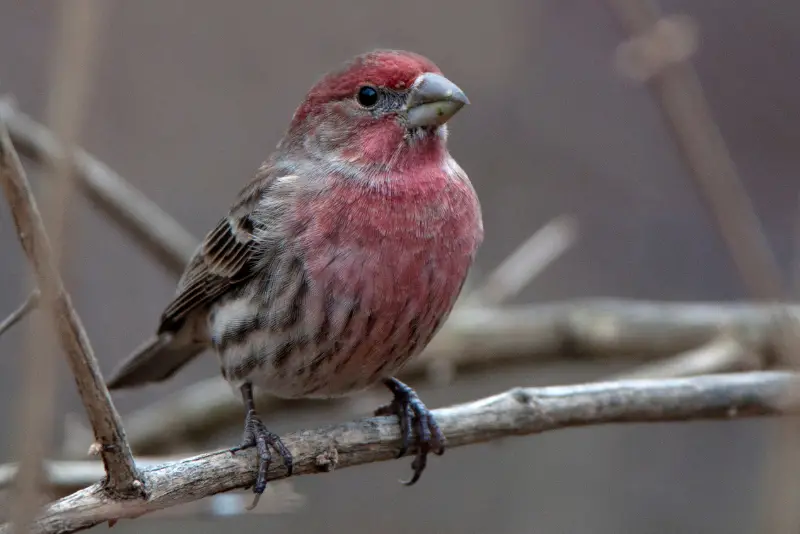
The House Finch is a common small bird in Arizona, and is mostly found in settled areas, ranging from small towns to large metropolitan centers.
Adult male House Finches can be identified by the bright red feathers on the head and upper breast, although in some cases they are slightly more orange or yellowish in color.
The females lack any red coloration, and instead have grayish streaks on a brown background.
The House Finch was originally a western bird, and it wasn’t until the 1940s that this bird was discovered in New York and other places on the east coast of the US.
The eastern House Finch population began to grow in the 1950s and 60s, and by the year 2000, it had expanded so far west that it connected with the original western population.
The House Finch is entirely herbivorous, and feeds on seeds, buds, and fruits.
If you set up a bird feeder in your backyard, you can expect House Finches to be among the first birds to visit it.
The House Finch is found throughout Arizona all year round, and while it doesn’t migrate, it does move to areas with more food outside of the breeding season.
Mourning Dove
Scientific name: Zenaida macroura
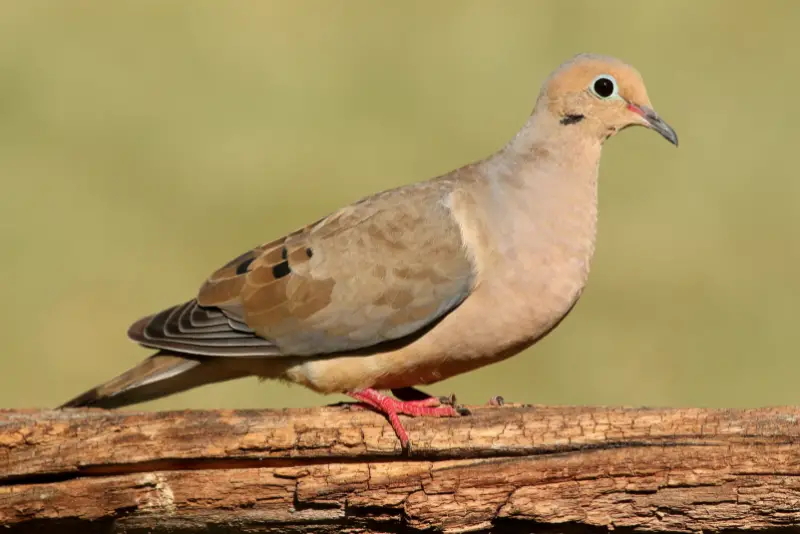
The Mourning Dove is one of the most common birds in North America, especially around farms and suburban areas.
This bird is almost entirely grayish-brown with a pale underside. The wings and the tail are pointed, and there is a small black dot on the side of the face.
When viewed up close, a grayish blue eyering as well as pink legs and toes are great distinguishing features of the Mourning Dove.
The Mourning Dove is a widespread breeding bird in Arizona, and can be seen year-round. During the winter it also frequents open woodland, but avoids large forests.
Lesser Goldfinch
Scientific name: Spinus psaltria
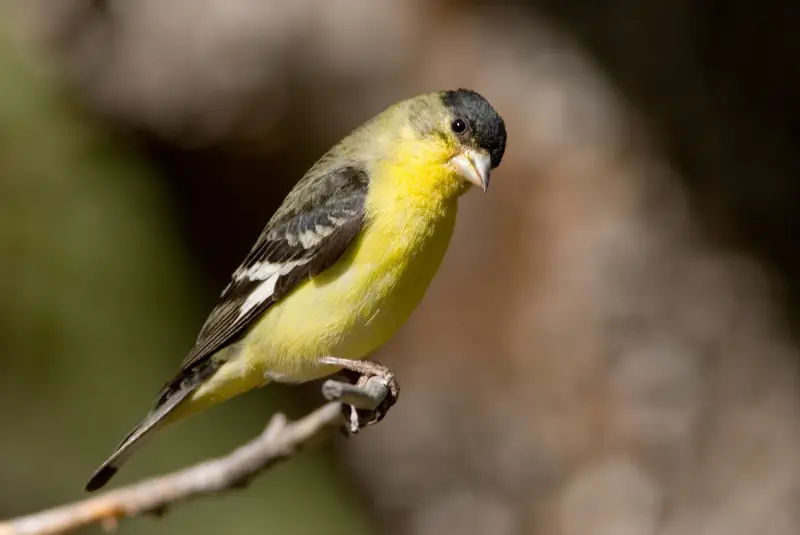
The Lesser Goldfinch is a common breeding bird in Arizona, and occurs in a broad swath across the southern half of the state.
Adult males have a black cap and black wings, which contrast with bright yellow underparts. Their black wings have a white stripe, which is most obvious in flight.
Females and juveniles are olive green, with lighter underparts and dark wings with a white wing bar.
The Lesser Goldfinch is a year-round resident in Arizona, and outside of the breeding season it likes to forage in flocks, mainly feeding on thistles.
Verdin
Scientific name: Auriparus flaviceps
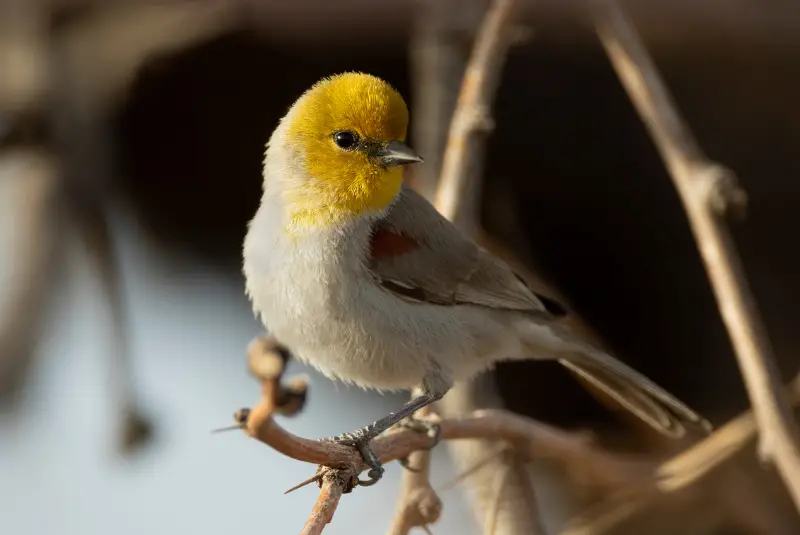
The Verdin is characterized by a slender body and an unusually slim beak that is more reminiscent of a warbler.
The colors of male and female Verdins are broadly similar, although the male’s yellow plumage is generally brighter.
The back, neck, and wings of adults are unassuming gray, contrasting with a startlingly bright yellow face, as well as piercing dark eyes.
And while it is an energetic feeder, twitching its tail as it goes, it can sometimes be difficult to spot, since it usually forages alone.
The Verdin is a regular breeding bird in the arid regions of southern Arizona, including the Sonoran Desert, where it can be seen all year round.
Gila Woodpecker
Scientific name: Melanerpes uropygialis
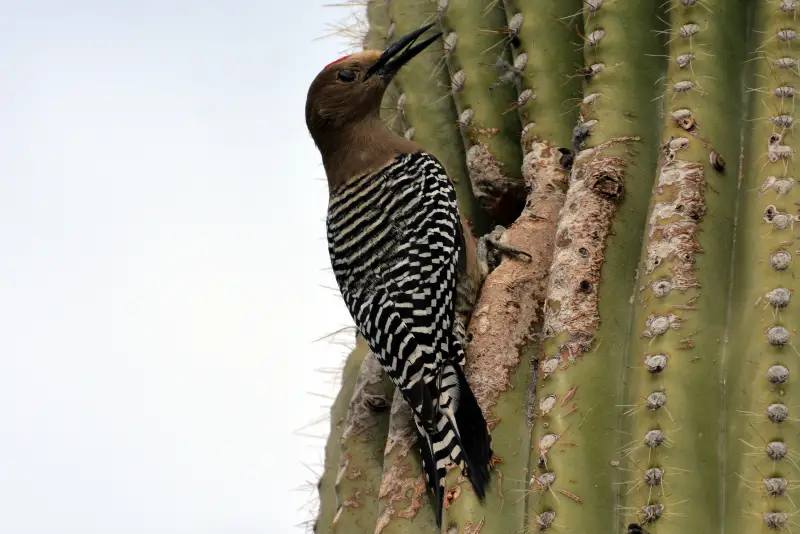
The Gila Woodpecker is a desert woodpecker that can survive in arid landscapes with almost no trees.
They achieve this by nesting in large cactus plants instead of trees, and feed on insects, cactus fruits and small berries that grow in the desert.
The holes dug by Gila Woodpeckers become highly sought after nesting sites once the woodpeckers abandon them, and are used by several Arizona owl species, as well as wrens and flycatchers.
These birds are commonly seen in the arid desert landscapes of southern Arizona, where they can be seen year round.
Northern Cardinal
Scientific name: Cardinalis cardinalis
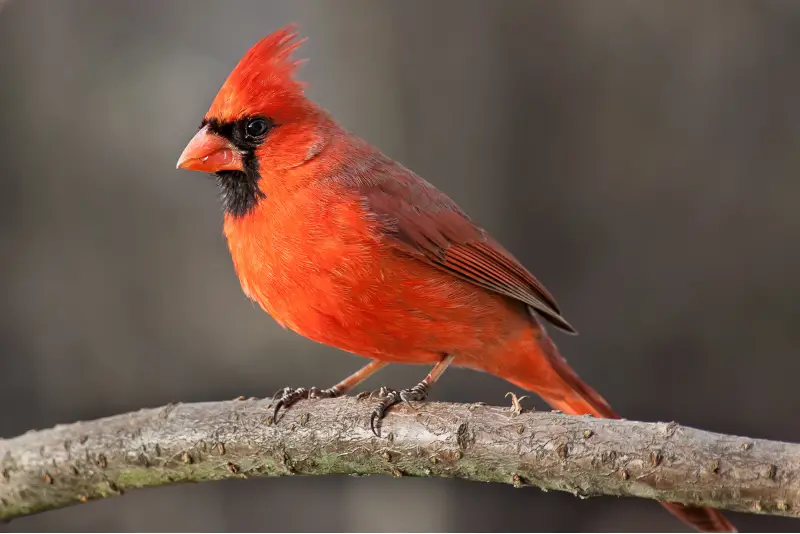
As the state bird of no less than seven US states, the Northern Cardinal is perhaps the most well known red bird in Arizona.
Male Northern Cardinals have a bright crimson red coloration on their head, chest, and belly, and slightly darker red on their back and wing feathers.
In addition, the face has a black mask extending from the bright red bill to the throat.
Female Northern Cardinals are not quite as colorful as males, and have a more buff-brown body color with some reddish tinges, although they also have a bright red bill.
The Northern Cardinal is a common backyard bird in Arizona, and can be seen year round in backyards, small forests, and parks.
During the winter months it doesn’t defend its territory, and sometimes gathers in flocks of up to 25 individuals that feed together. The Northern Cardinal is a regular visitor at bird feeders.
American Robin
Scientific name: Turdus migratorius
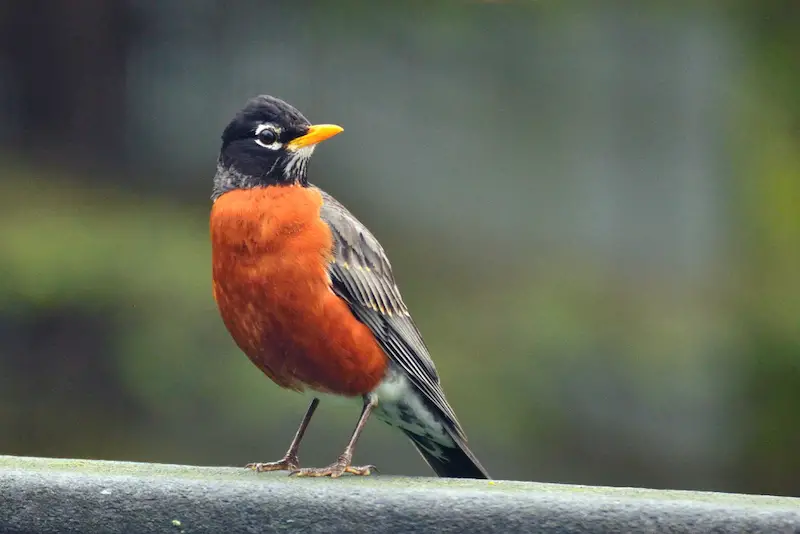
The American Robin is actually a thrush, but got its name from early settlers in North America who noticed its resemblance with the European Robin.
The orange chest of the American robin makes it easy to identify this type of bird. It mostly forages for food on the ground with the help of its powerful legs and stout yellow beak.
In the fall and winter, it feeds on fruit and searches for snails and worms amid the fallen leaves. It frequently congregates in big roosts in the non-breeding season.
The American Robin is a superb singer, with a song that is melodious and flowing, similar to many other thrushes.
They construct their bulky nests out of twigs at a very variable height, from the ground all the way up to the canopy of the trees.
In a typical year, American robins will have between two and three broods.
While the original habitat of American Robins was woodlands, they have adjusted superbly to the expansion of human settlements, and are now found in suburban areas as common breeding birds.
This thrush is a partial migratory bird, with its northernmost populations in Canada and the northern USA being entirely migratory.
In Arizona, the American Robin is found all year round, and likes to form flocks that roost together during the winter.
Northern Mockingbird
Scientific name: Mimus polyglottos
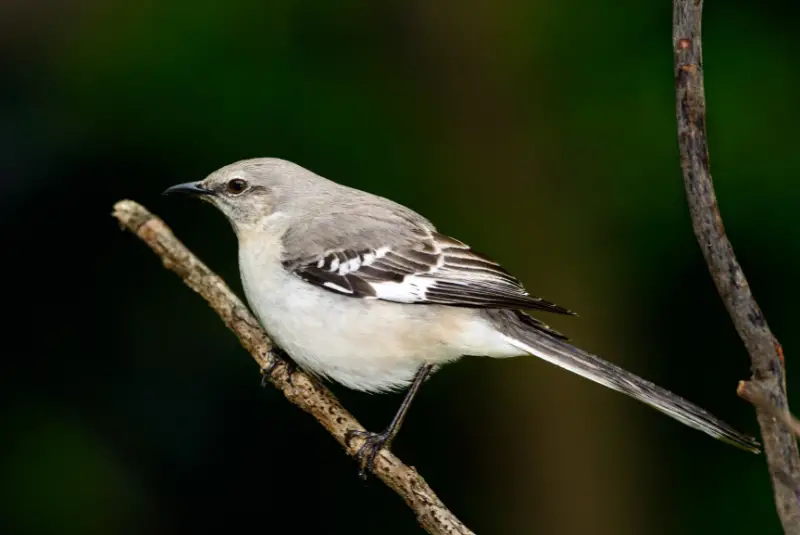
The melodious whistling song of the Northern Mockingbirds can be heard in many parts of Arizona, and is most often heard at night.
Its overall appearance is dark gray, although its black wings have white stripes (which are especially conspicuous in flight, flashing like bright signals).
It is a common backyard bird in Arizona, with both sexes resembling each other. In addition to the black wings, the tail is also black, and has white margins.
It has a dark eyestripe that contrasts with the yellow eye, while the underparts are buff white. Juvenile birds look similar to adults, but are covered with spots and streaks.
The Northern Mockingbird is a common songbird, and a year-round resident in Arizona. It is also a summer visitor in the northernmost states as well as Canada.
This bird is the only mockingbird species found in North America. It prefers wooded areas as well as urban habitats with sufficient tree growth, such as parks and golf courses.
House Sparrow
Scientific name: Passer domesticus
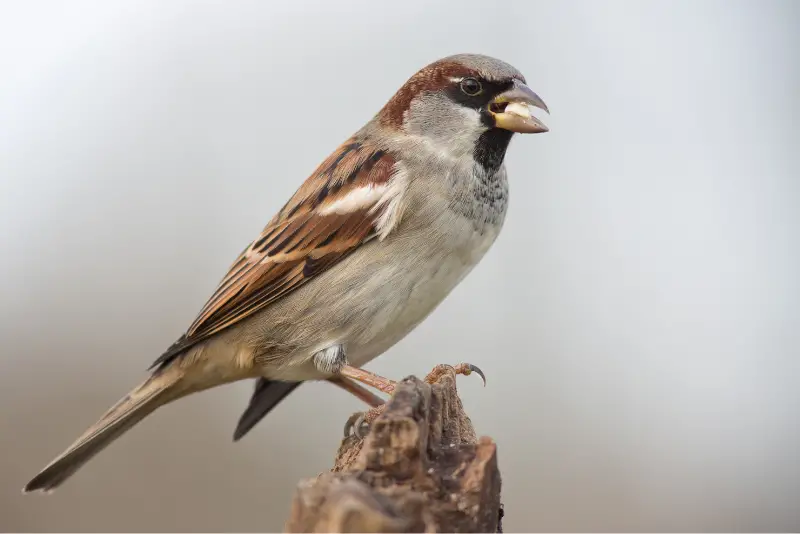
The House Sparrow is a familiar urban songbird in Arizona.
Adult males have upperparts that are primarily chestnut brown with dark streaks. The wings are chestnut brown with a white wingbar.
A great characteristic to identify males is by their gray crown and rump. Females are more drab, and are mostly buff gray with dark streaks on their back.
The House Sparrow is not a native bird of the lone state, but was introduced by European settlers.
However it has successfully colonized the entire North American continent, and is now a common urban bird that is found in parks and backyards.
American Crow
Scientific name: Corvus brachyrhynchos
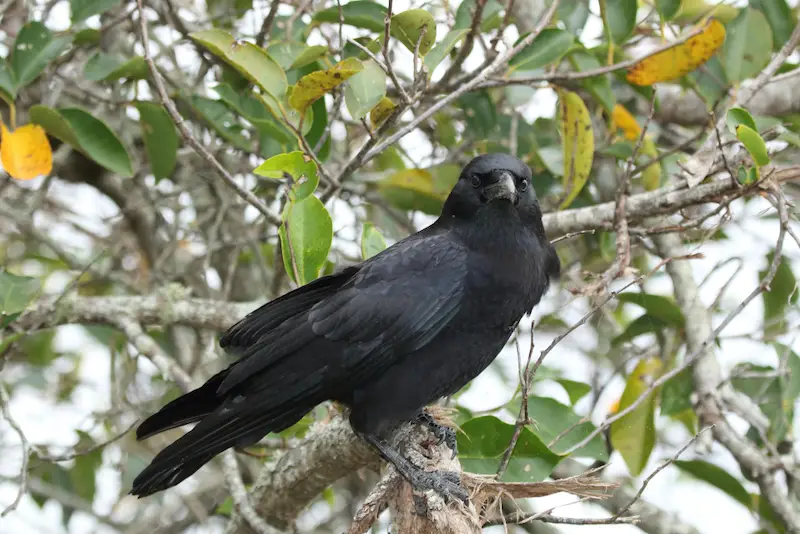
American Crows are quite large Arizona birds that are entirely black, including black beaks, legs, and eyes. Both adults and immature birds are completely black, and hard to distinguish from each other .
This is one of the most intelligent birds in the world. It also happens to be one of the most sociable, and it likes to pass the time by harassing other birds.
This is a common and easily recognizable black-colored bird in Arizona. Similar to vultures and birds of prey, American Crows like to feed on roadkill, but rarely get hit by cars themselves.
Family groups of crows sleep together at night but split off during the day to go foraging.
Outside of the breeding season, this bird forms massive flocks, sometimes topping out at thousands of birds.
The American Crow builds a big stick nest in trees, which it likes to reuse for many years. Old crows nests are also used by many other birds, including Arizona birds of prey.
American Crows are common in Arizona in open forests and woodlands, as well as farmland and urban areas such as parks, golf courses, and large gardens.
Cactus Wren
Scientific name: Campylorhynchus brunneicapillus
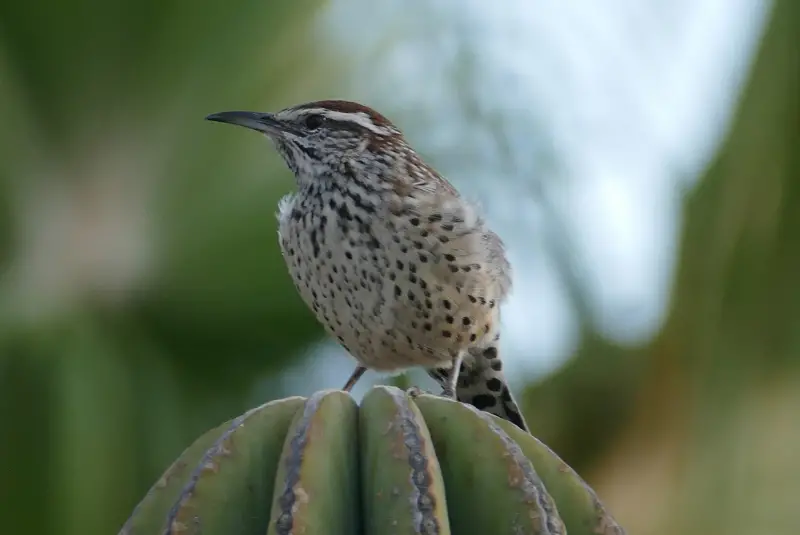
If you notice a desert bird resembling a cross between a thrasher and a wren perched on a cactus, you’re probably looking at a Cactus Wren, the state bird of Arizona.
Both sexes of this bird look alike, and are predominantly grayish brown with dark brown spots and streaks thrown in for good measure.
The best distinguishing features of the Cactus Wren are its brown crest, the long and slightly downturned bill, as well as the bright white eyebrow stripe.
You can also identify it by its harsh, chattering call, which sounds like someone trying to start a car. If you get close enough to one of these birds, you’ll notice that their eyes are dark ruby red.
The Cactus Wren is a year-round resident of the southern half of Arizona, and is commonly found in desert landscapes.
As you might have guessed from its name, it’s often found near cacti and uses them as a lookout when searching for insects and other small invertebrates on the ground.
Common Starling (European Starling)
Scientific name: Sturnus vulgaris
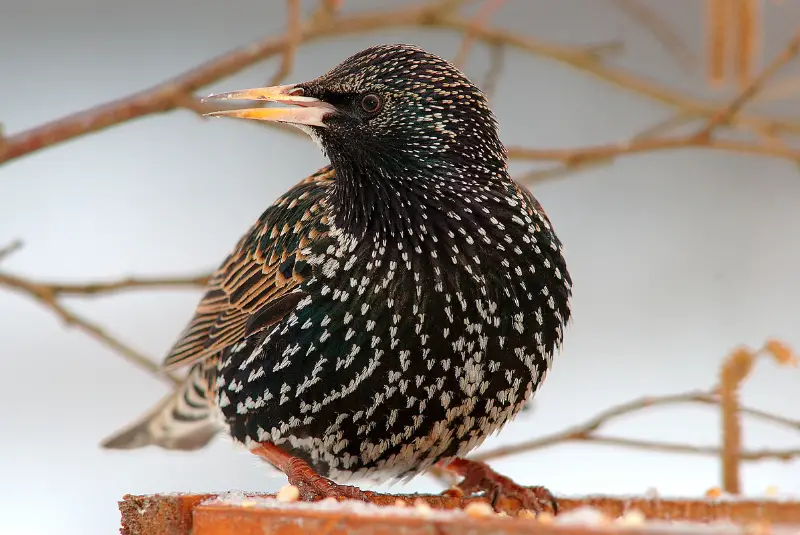
The Common Starling (also known as European Starling) is a common backyard bird in the Grand Canyon State. Adult Common Starlings are uniformly black with a glossy sheen.
During winter, the black feathers of Common Starlings are covered with light spots, which can be a great characteristic to identify them.
This species is originally from Europe, Asia, and North Africa, but it was introduced to North America and many other parts of the world, where this bird has established itself as a successful breeding species within a short period of time.
Common Starlings inhabit open country with few trees as their original habitat, but they are also among the most successful urban birds, and are especially common in parks and gardens.
While Common Starlings nest in tree holes in the wild, they are also known to nest inside buildings and nest boxes in urban settings.
Unfortunately, native birds are sometimes driven out of their nesting sites by competing Starlings.
Similar to grackles and other blackbirds, Common Starlings form large flocks outside of the nesting season.
These flocks can contain more than a million individuals, and can be seen performing amazing aerial acrobatics.
White-winged Dove
Scientific name: Zenaida asiatica
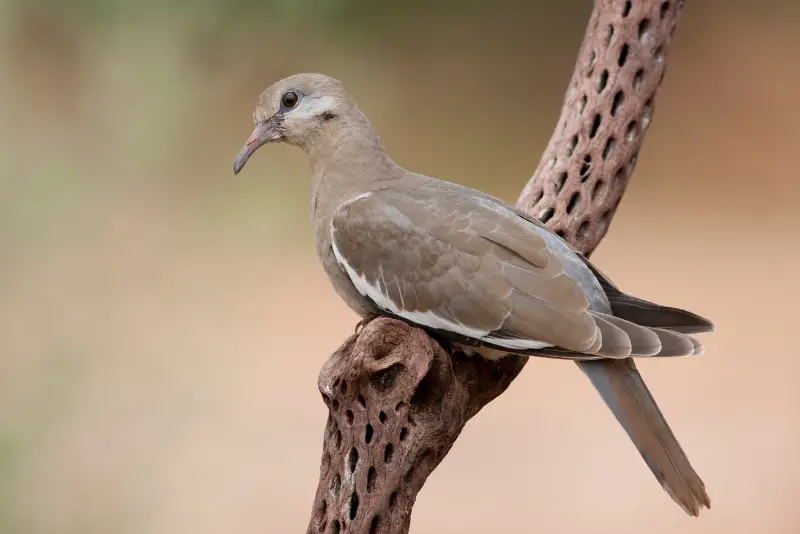
The White-winged Dove used to be a bird of remote desert areas.
But as a result of adapting to man-made habitats, it is a summer visitor and breeding bird in cities and towns across the southern US, including the southern half of Arizona.
This dove is almost entirely light gray, except for a bright white stripe on its wings.
The white areas on the wings are most prominent when it takes to the air, and are a great feature for identifying this species.
It also has a black spot on its cheek, and if viewed close enough, its bright orange eye with a light blue eyering is a great distinguishing feature.
These doves are frequently found in urban and suburban areas with suitable nesting trees, and are most often encountered foraging on the ground.
During the winter, these doves fly south to spend the cold season in Mexico, although there is a small population in the southernmost part of Arizona that is non-migratory.
Red-winged Blackbird
Scientific name: Agelaius phoeniceus

The Red-winged Blackbird is one the most abundant birds in Arizona, and it is definitely the most common blackbird found in the Grand Canyon State during the summer.
The great thing about these Arizona blackbirds is that you can easily distinguish males from females.
Male Red-winged Blackbirds are completely black except for the bright red patches on their wings. In contrast, females (and juvenile birds) are a blackish brown color with white streaks.
Generally speaking, this blackbird lives in open fields and near water. This bird is often found in marshes, wetlands, and around lakes.
To find food, the Red-winged Blackbird travels many miles a day, especially outside of the nesting season.
While this blackbird is primarily a seed-eater during fall and spring, it switches to feeding almost exclusively on insects during summer.
Depending on where this bird is found, the Red-winged Blackbird is either a seasonal migrant (in the north of its range), or a resident (in the south of its range).
Red-winged Blackbirds roost in flocks up to millions of individuals strong, creating a deafening noise with their rapidly beating wings.
In spring, males are usually the first ones to arrive in order to claim a desirable territory before the females arrive.
During the mating season, the male will sing from a conspicuous perch and display the red shoulder patches on his feathers in order to attract the attention of females.
After a female chooses a mate, she builds her nest over shallow water in a thick stand of vegetation. Her chosen mate then aggressively defends the nest against other blackbirds.
The most successful males are bigamous, and can mate with multiple females at the same time.
Downy Woodpecker
Scientific name: Picoides pubescens

The Downy Woodpecker is the smallest woodpecker in the Grand Canyon State, and is most commonly found in east Arizona.
While males are black and white with a small red patch on their nape, females are entirely black and white.
The wings of both sexes are black with white bars, which look like spots when the wings are folded.
Downy Woodpeckers are non-migratory, and can be seen all year round throughout North America, except for the arid regions in southern states.
You can tell this woodpecker apart from the Hairy Woodpecker by its smaller size and short bill.
While Downy Woodpeckers don’t migrate, they like to move around outside of the breeding season, in search of areas with plentiful food.
Their preferred habitat is deciduous or mixed forest, where they feed on insects and insect larvae found under the bark of trees. During winter they also eat berries and seeds.
Hairy Woodpecker
Scientific name: Picoides villosus

The Hairy Woodpecker looks similar to the Downy Woodpecker, but has a longer, thicker bill, and is a much larger bird overall.
Both the male and the female have black upperparts with white bars on the wing feathers, which look like spots when the wings are folded.
The male has a very small red patch on the back of its head, which is considerably smaller than the red patches on other woodpecker species.
The Hairy Woodpecker is a common breeding bird found throughout North America, and can be seen in Arizona year-round.
This woodpecker breeds in both coniferous and deciduous forests, and is even found in parks and other urban areas with trees.
House Wren
Scientific name: Troglodytes aedon
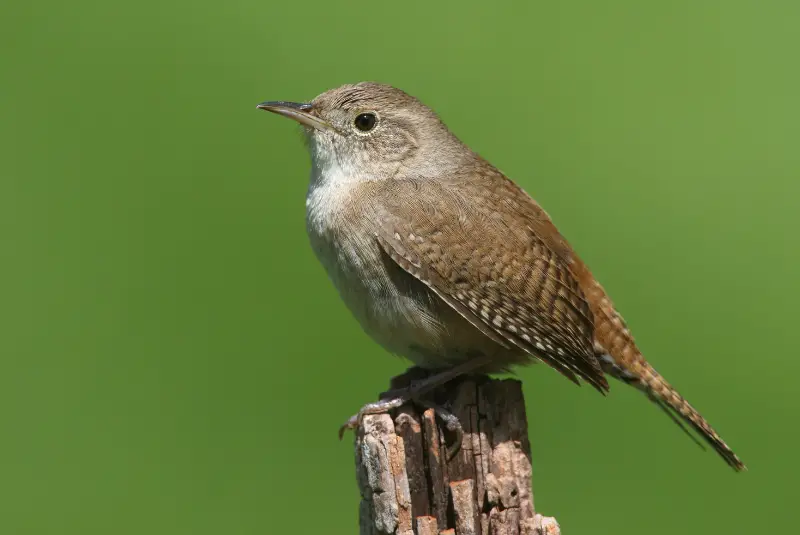
The House Wren is a small songbird with a relatively long beak. Compared to other wrens, it has a long tail, which it likes to cock up.
At a distance, House Wrens resemble uniformly brown birds, but when viewed close up, you can discern subtle barring on their wings and tail.
This small bird has a surprisingly loud voice, and if you hear one singing next to you, it appears almost deafeningly loud, drowning out all other birdsong in the vicinity.
In contrast to the Rock Wren, which is a year-round resident in Arizona, the House Wren is a summer visitor in Arizona, where it can be found from May to August.
Yellow-rumped Warbler
Scientific name: Setophaga coronata

While the sexes of the Yellow-rumped Warbler are dissimilar, they both have a yellow rump.
This warbler exists in several variations, and the eastern population that can be found in Arizona are also called “Myrtle Warblers”.
These Arizona birds have blueish-gray upperparts with dark streaks, as well as a yellow rump and yellow flanks.
The Yellow-rumped Warbler is a summer breeding bird in northern Arizona, and a winter visitor in the southern parts of the state, where it can be seen from August through April.
Bullock’s Oriole
Scientific name: Icterus bullockii

Bullock’s Oriole is a western species that is a summer breeding bird in the western half of Arizona.
Adult males are flaming orange coupled with a jet black back and a black neck. They also have a large white patch on the wing, and an orange face with a black throat.
Juveniles and females are more grayish-yellow with orange on their face and chest. Endemic to the western United States, it spends the winter in Mexico.
Bullock’s Oriole forages for food on the upper branches of trees and shrubs, searching for fruits and insects.
You can encounter these Arizona orioles in open woodlands close to rivers and streams, as well as in parks and orchards.
Barn Swallow
Scientific name: Hirundo rustica
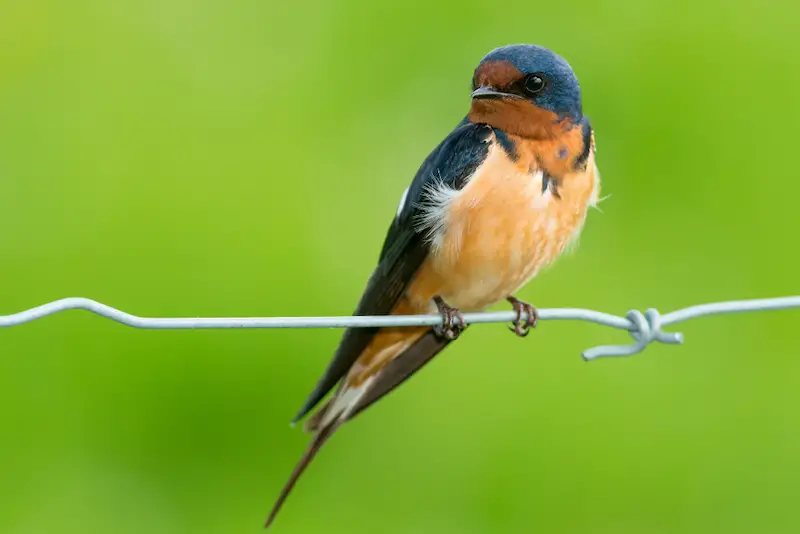
The Barn Swallow inhabits nearly all of North America south of the Arctic circle and may be found in a wide variety of habitats.
It has iridescent blue upperparts that shimmer in various shades of dark blue when the sunlight hits them.
Its underside is reddish-orange, including a chestnut orange forehead and throat, as well as a light reddish-orange belly.
The deeply forked tail of Barn Swallows is another great feature you can use to identify this bird.
However, keep in mind that immature barn swallows have a duller plumage than adults, as well as a shorter tail that is less forked.
The Barn Swallow used to nest in caves and hollow trees, but nowadays it prefers to do so beneath the overhangs of buildings and bridges, as well as inside barns (which explains how it got its name).
These swallows in Arizona are still a reasonably common sight in most areas. However, the overall numbers of Barn Swallows have been steadily decreasing, especially in the northern section of their range.
This decline is likely a result of the loss of foraging areas and nesting opportunities.
The Barn Swallow feeds on flying insects, such as mosquitoes and flies, and catches them closer to the ground than other species of swallows. In its winter quarters it also feeds on termites.
It is a strictly migratory bird, and spends the winter in Central and Southern America.
Violet-green Swallow
Scientific name: Tachycineta thalassina
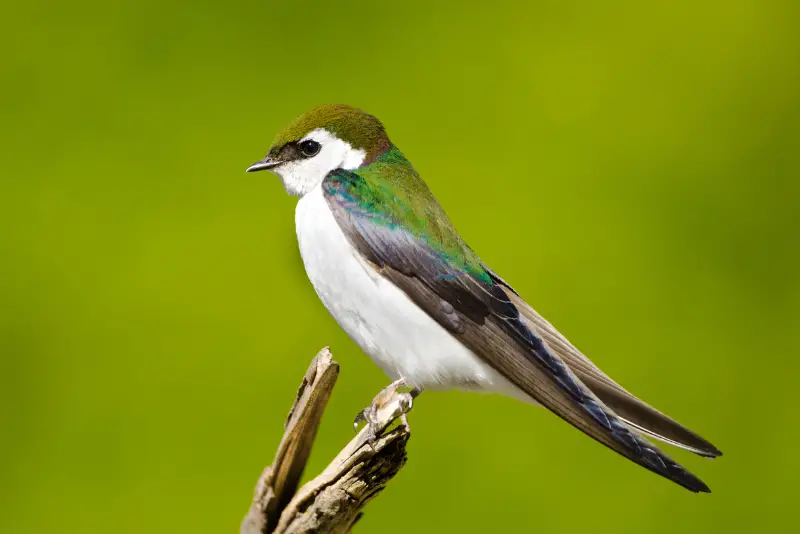
This beautiful swallow is a bird of the western USA, and is found as a summer visitor throughout Arizona.
While this bird initially looks like it has an entirely dark upper side, when it catches the sunlight, you’ll notice the iridescent green plumage on its back.
These green birds readily accept nesting boxes, and other nest cavities in urban areas. They are most often observed hunting insects over Arizona rivers and lakes.
During the cold season they migrate south to spend the winter in Mexico and Central America.
Yellow Warbler
Scientific name: Setophaga petechia
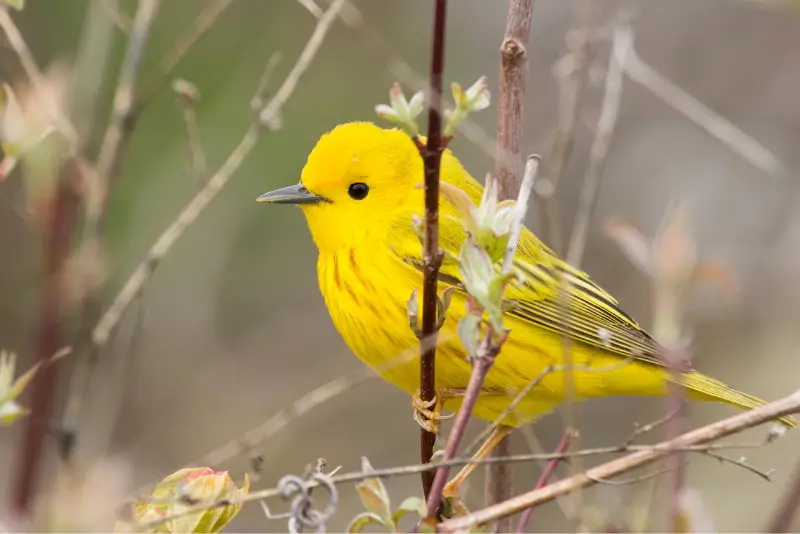
Also known as the American Yellow Warbler, this songbird lives up to its name.
Adult males have a brilliant yellow color, except for their wings, which are just slightly darker and have two pale wingbars.
They also have reddish stripes on the breast and the yellow sides. Adult females are very similar to the males, but have less black streaking and are thus more uniformly yellow.
These bright yellow-colored Arizona birds are summer visitors in the state during the months from May to late August.
This species is found in open habitat with low thickets and scrubland, which makes it easy to observe.
Western Bluebird
Scientific name: Sialia mexicana
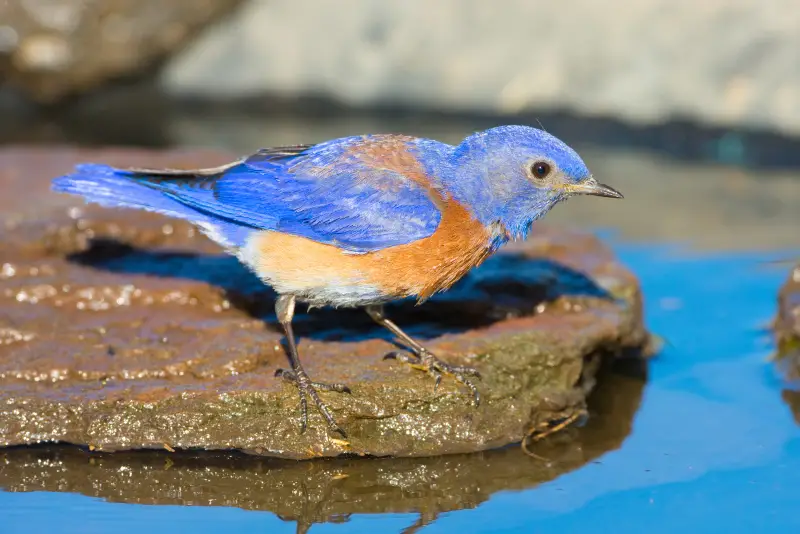
The Western Bluebird is the most common bluebird species found in Arizona.
It is a breeding bird and year-round resident in the northern half of Arizona, and also occurs in southern parts of the state during the winter season.
Male Western Bluebirds have a deep shade of blue on their backs, and orange on the chest.
Female and juvenile birds on the other hand, have more subdued hues, with gray-brown upperparts and a lighter gray underside.
While Western Bluebirds are migratory birds in northern parts of their range, they are permanent residents in the Grand Canyon state.
These birds nest in treeholes or nestboxes, but have suffered from the competition with House Sparrows and European Starlings, which are more aggressive and chase bluebirds away from their nest sites.
The population of these Arizona bluebirds underwent a dramatic decline at the end of last century, due to lack of nesting holes and competition with European Starlings.
However, thanks to the efforts of numerous Arizona citizens providing nest boxes for Western Bluebirds, these birds are a common sight in Arizona once more.
Pyrrhuloxia
Scientific name: Cardinalis sinuatus
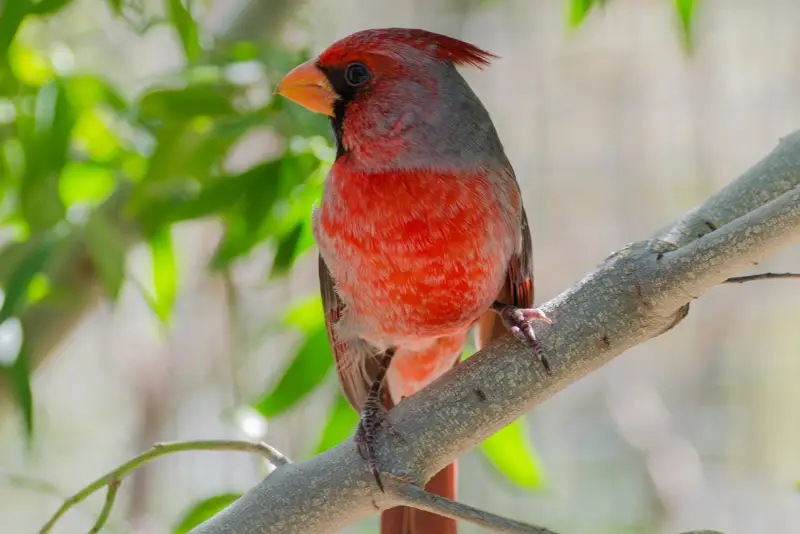
The Pyrrhuloxia is closely related to the Northern Cardinal, and can be viewed as its desert counterpart, which explains how it got the nickname “desert cardinal.”
Adult males are dark gray on their back, which contrasts with their bright red mask, crest, tail, and chest.
Females have more muted gray colors, except for pink plumage on their chest and belly.
The Pyrrhuloxia is a year-round resident in arid zones of Arizona, and is fiercely territorial during the breeding season.
During the winter months, it becomes more social and forms flocks that rove around together and sometimes show up at bird feeders.
Anna’s Hummingbird
Scientific name: Calypte anna
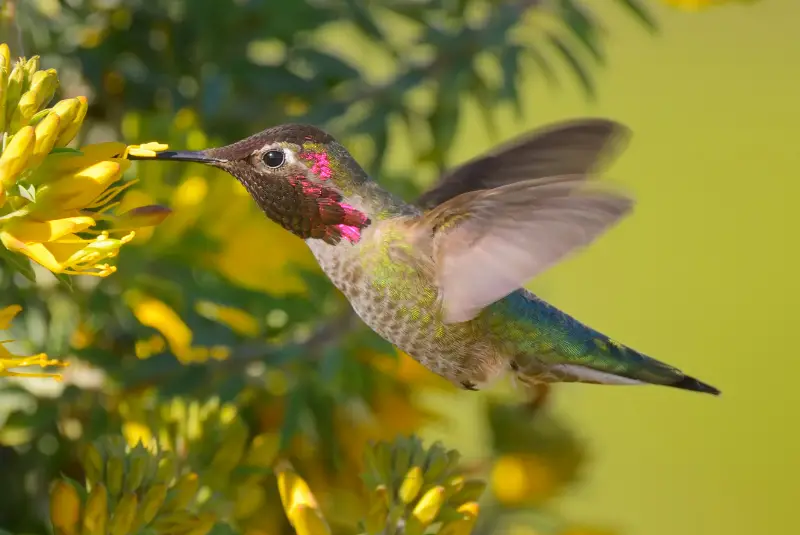
A compact Calypte hummingbird species that thrives in human habitats, Anna’s Hummingbird is the smallest bird found in Arizona.
This intrepid hummingbird has steadily and relentlessly increased its breeding range since the early 1900’s, spreading from coastal California to more interior regions of the continent.
And as part of this expansion of its range, Anna’s Hummingbird has colonized urban areas in Arizona and other desert states of the southwestern United States.
This tiny bird is now a common backyard bird in Arizona, where it nests in gardens, parks, and other urban areas.
Anna’s Hummingbirds are highly adaptive when foraging for food, and are able to utilize a broad range of nectar sources, including flowering trees and shrubs from different continents.
Lazuli Bunting
Scientific name: Passerina amoena
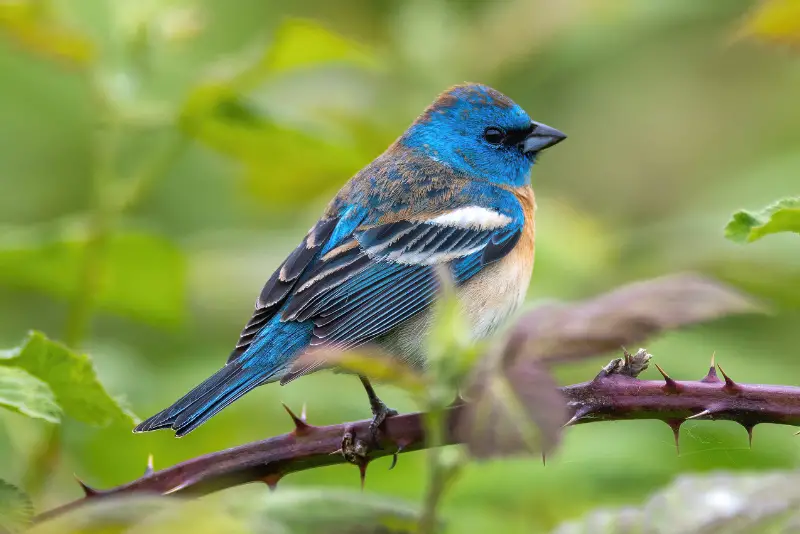
The Lazuli Bunting is a gorgeous little songbird of the western United States that visits and breeds in northern Arizona during the summer.
The hood, neck, and rump of adult males are light blue, while the wings are dark gray with a white wingbar. Males also have a chestnut orange breast and a white belly throughout the summer months.
Females are buff-brown in color with black wings and a pale blue rump.
The Lazuli Bunting may be found in Arizona during the breeding season, which runs from May to August, before migrating to Mexico for the winter.
Common Ground Dove
Scientific name: Columbina passerina
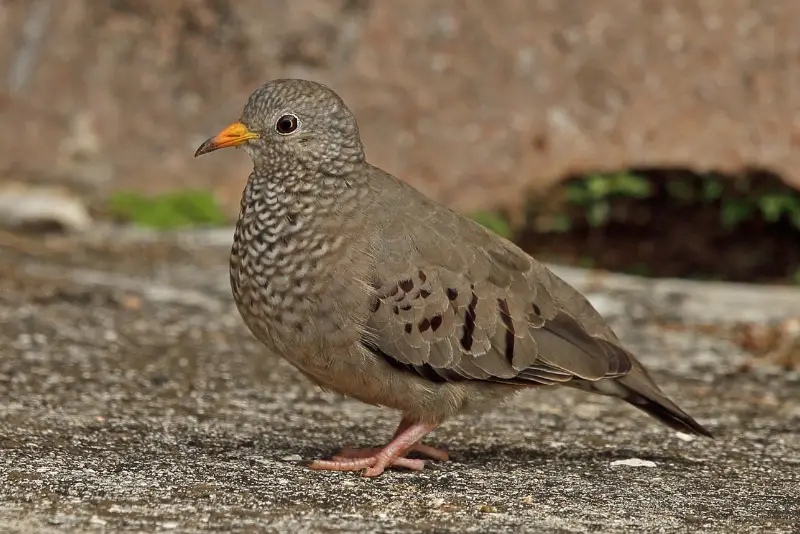
The Common Ground Dove is a small dove that’s about the size of a sparrow. It is one of the species of birds found in the southern US states, and is common throughout southern Arizona.
The overall coloration of Common Ground Doves is brownish gray, with chestnut tones on the wings. In combination with their small size, the subdued dusty color makes these birds hard to spot on the ground.
Often you won’t notice these birds until you flush them from the ground, and see them flying away.
Another great way to identify them is by their repetitive coo-ing call, which is audible even if you can’t catch a glimpse of the bird since it’s hidden in thick scrub.
Common Ground Doves are year-round residents in the southern parts of the state. They readily visit ground bird feeders that offer shelled sunflower seeds and other seeds.
In their original desert habitat, these birds are opportunistic breeders that raise their young after plentiful rainfall leads to an abundance of seeds.
They nest on the ground, which makes them vulnerable to cats and other predators. This explains why these birds are so well camouflaged, which allows them to blend in with their surroundings.
Woodhouse’s Scrub Jay
Scientific name: Aphelocoma woodhouseii
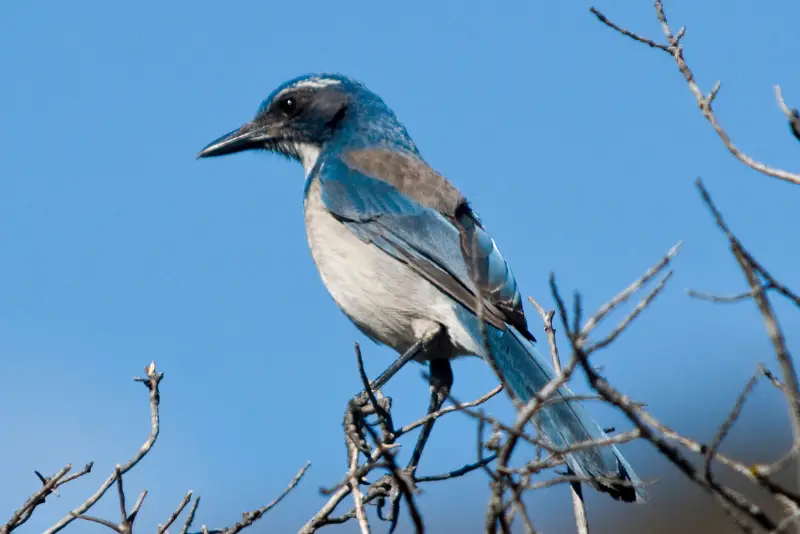
The Woodhouse’s Scrub Jay was called the Western Scrub Jay until a few years ago, and was thought to belong to a single species that occurs throughout the western United States.
However, in 2016 it was split into two different species, the California Scrub Jay (found along the Pacific Coast), and the Woodhouse’s Scrub Jay (found further inland). The population in Arizona belongs to the latter species.
This bird is the most widespread jay species in the Grand Canyon State, and is a common bird throughout Arizona, except for the Sonoran Desert.
Adult males and females look the same, and have an azure blue upper head, wings, and tail, as well as dark gray shoulders and a light gray belly. The largely blue body contrasts with a white throat streaked with gray.
These jays are year-round residents that can be encountered in a variety of lightly wooded habitats and scrub land.
Steller’s Jay
Scientific name: Cyanocitta stelleri
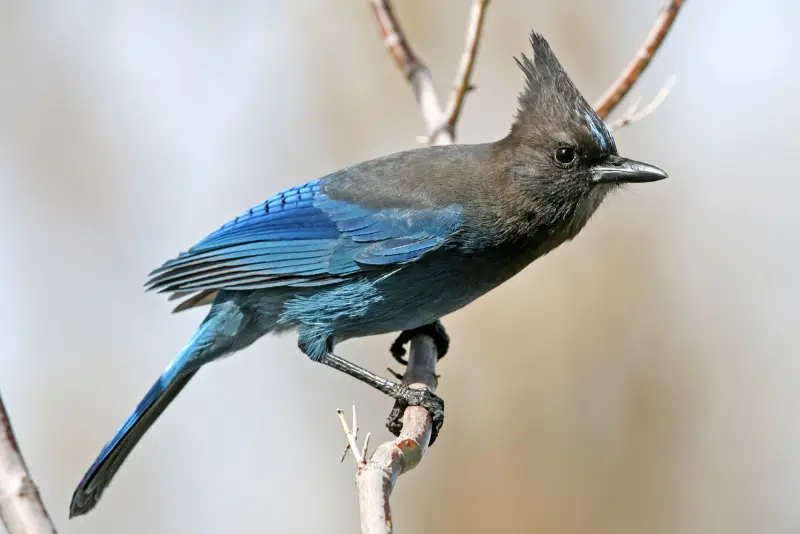
Steller’s Jay is a medium-sized member of the jay family, and is easily recognized due to the dark blue body combined with its striking crest.
It is a common breeding bird in northern Arizona, but is absent from the more arid areas in the south, including the Sonoran Desert.
Both males and females look similar, and have a dark gray to blackish head, nape, and upper back, while the rest of the body is dark admiral blue.
While it is found year-round within its breeding range, in some years Steller’s Jays undertake irruptive movements towards the south, and show up in areas where they normally don’t occur.
Chipping Sparrow
Scientific name: Spizella passerina
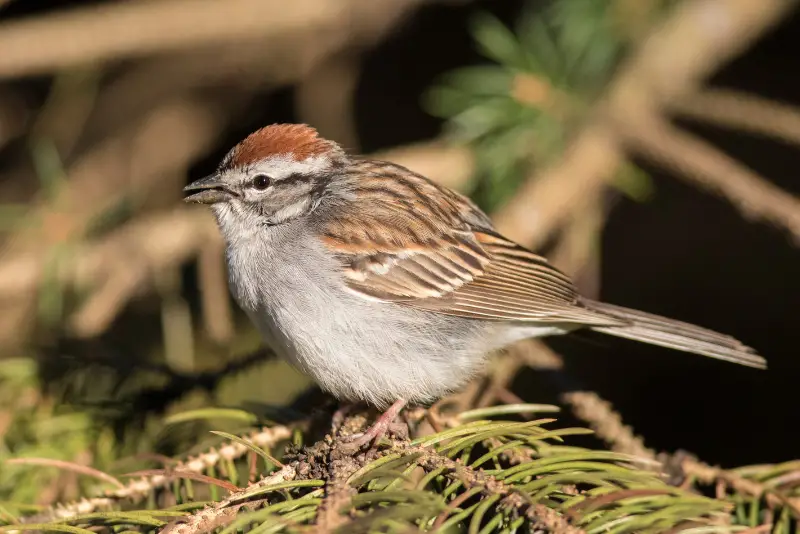
The Chipping Sparrow is a common bird in many man made habitats, including backyards, gardens, and parks.
Adult birds can be recognized by their chestnut crown, which contrasts with a white supercilium (or eyebrow stripe) and black eye stripe.
The Chipping Sparrow is a widespread and common breeding bird in Arizona, where it can be seen as a summer visitor from May through October.
These birds migrate south and spend the winter in the southern USA, as well as Mexico and Central America.
Song Sparrow
Scientific name: Melospiza melodia
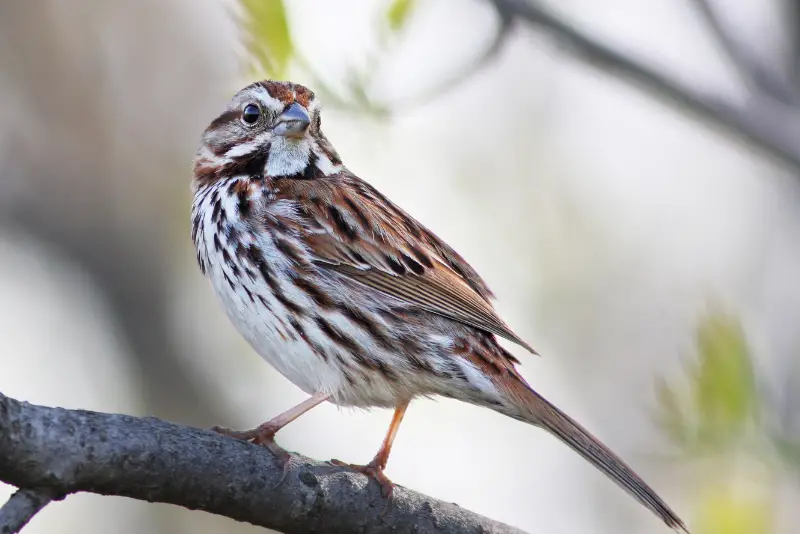
The Song Sparrow is an inconspicuous little brown bird, but can be recognized by its dark breast markings that merge into a central black spot.
The back is reddish brown with dark brown streaks, and the reddish wings have two white wingbars.
The Song Sparrow is a common summer visitor in Arizona, where it can be seen from April to October.
It spends the winter in more southern states, and also in Mexico. Song Sparrows prefer fields and meadows with scrubs and dense bushes.
What are the top 5 most common birds in Arizona?
The top 5 most common birds in Arizona are:
- House Finch
- Mourning Dove
- Lesser Goldfinch
- Gila Woodpecker
- Verdin
Out of these 5 species, the House Finch is the most frequently seen backyard bird that lives in Arizona, and is reported in 49% of eBird checklists submitted for Arizona.
While all of these birds are common Arizona backyard birds, they can also be found in remote areas.
How can you attract birds to your yard in Arizona?
The top 5 things you can do to get Arizona birds to visit your backyard are as follows:
- Set up a feeder with sunflower seeds, or a bird seed mix
- Set up a bird bath
- Plant shrubs to provide nesting opportunities
- Plant native fruiting plants to provide foraging opportunities
Tip: If you want to attract Western Bluebirds to your backyard feeder, it’s best to offer berries and mealworms, since they’re not interested in seeds.
If you enjoyed this article, check out our guide to the herons of Arizona.

